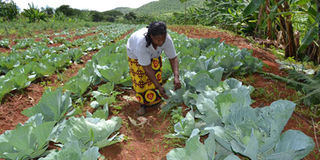Forget relief rations, we now export our food

Josephine Kioko in her banana and vegetable farms at Kabaa Irrigation Scheme in Machakos. PHOTO | ISAIAH ESIPISU | NATION MEDIA GROUP
What you need to know:
- Kabaa scheme dates back to 1924 when Christian missionaries and locals entered into an agreement with the government to construct a dam. It collapsed after the missionaries left due to poor maintenance.
- For years, residents suffered but in 2010, the Ministry of Agriculture with the support of the Africa Development Bank under a small-scale horticulture development project rehabilitated the dam.
- Drip irrigation saves water and fertiliser by allowing them to drip slowly to the roots of plants through a network of valves, pipes, tubing, and emitters.
Five years ago, Josephine Kioko, a resident of the semi-arid Kitwamba village in Machakos County was among residents who periodically queued for food aid, locally known as mwolio.
But that was then. Today the middle-aged mother of two is producing enough food which she grows at the rehabilitated Kabaa Irrigation Scheme. She feeds her family and exports some.
“Life has taken a turn for the better,” says Kioko. “In 2008, I was just a helpless woman, struggling to feed my children but today I am a proud farmer who is able to educate her children and feed many others,” she says.
On her six acres, Kioko grows maize, beans, tissue culture bananas, sukuma wiki (collard green), cabbages and cowpeas for local consumption, and French beans, capsicum and chili for the export market.
On average, Kioko says she pockets not less than Sh100,000 a month from her farming.
Her household is one of 284 from Mwala sub-county which directly use water from River Athi through irrigation whose canal covers 7km to and covers 593 acres.
The water is diverted from a higher ground to allow free flow using gravity.
Kabaa scheme dates back to 1924 when Christian missionaries and locals entered into an agreement with the government to construct a dam. It collapsed after the missionaries left due to poor maintenance.
For years, residents suffered but in 2010, the Ministry of Agriculture with the support of the Africa Development Bank under a small-scale horticulture development project rehabilitated the dam. The rehabilitation was completed in August 2011.
“To sustain irrigation, we encouraged the residents to register an association,” says James Kariuki, Mwala sub-county agricultural officer.
The residents formed Kabaa Irrigation Water Users Association, which was registered in 2010. Francis Mutinda, the association’s secretary, says each member pays Sh200 every month and Sh1,500 every year to maintain the canal. “We have employed two people who routinely survey the canal to ensure that it is not blocked or silted.”
Agricultural officers from the government have trained farmers on good agronomic practices, farming for agribusiness, pest control, marketing and financial management, among many other skills.
“Since this project was completed, Records show that the 284 households have earned Sh287 million since 2011 after selling produce to the local and export market. On her farm, Kioko uses a petrol-driven water pump to fill two 10,000 litres tanks raised 10m from the ground. The water then flows down to her farm into drip pipes.
Drip irrigation saves water and fertiliser by allowing them to drip slowly to the roots of plants through a network of valves, pipes, tubing, and emitters.
Next to Kioko’s farm and home is Daniel Mutiso’s patch. The farmer is completing his five bedroom house that has so far cost him Sh2 million. The money comes from the proceeds of his farm.
The 69-year-old grows tissue culture bananas that earn him at least Sh25,000 a month.
“My main crop is French beans, which I grow for export. It gives me at least Sh150,000 per season from just a quarter an acre of my six acres,” he explains. He adds that they export through different agents to Europe and the Middle East.
He also grows red chili for export, cassavas, sweet potatoes, maize, beans and various vegetables.
“The canal supplies more than enough water to serve everybody within the scheme,” says Kariuki. It releases 225 litres a second, which can serve an even bigger area.
Kioko and Mutiso says they make more profits during dry spells.





